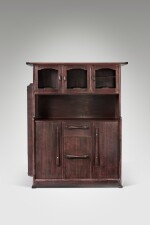Crafting Modernism: Masters of the American Studio Design Movement from the Pinnacle Art Collection
Crafting Modernism: Masters of the American Studio Design Movement from the Pinnacle Art Collection

Greene & Greene
Cabinet from the Studio of Charles Sumner Greene, Carmel, California
Auction Closed
June 10, 03:47 PM GMT
Estimate
200,000 - 300,000 USD
Lot Details
Description
Greene & Greene
Cabinet from the Studio of Charles Sumner Greene, Carmel, California
circa 1907-1911
executed in the workshop of Peter Hall, Pasadena, California
Honduran planked mahogany, iridescent glass
72 5/8 x 57 1/2 x 23 3/8 in. (184.5 x 146 x 59.4 cm)
Charles Sumner Greene, Carmel, California
Thence by descent
Christie's New York, December 9, 1995, lot 260
Isak Lindenauer
Private Collection, New York, circa 1990s
Rago Auctions, Lambertville, New Jersey, October 25, 2008, lot 547
Acquired from the above by the present owner
The present cabinet, made by the Halls for Charles Sumner Greene’s own use in his studio in Carmel, provides a focused encapsulation of their jointly achieved aesthetic. It has several features typical of their work, including subtly shaped handles and gently rounded terminations on the moldings. The material, a Honduras mahogany darkened with fuming (a process involving exposure of the timber to ammonia, which causes a chemical reaction in the tannins), sends quite a different message from the sturdy white oak preferred by the other Arts and Crafts makers like Gustav Stickley. Interestingly, a period photo of Charles Greene’s office shows that the piece stood right next to an oak filing cabinet that he himself had made back in 1903, in the Stickley style.2 The juxtaposition shows the progression of his sensibility, and attests to the all-important contribution that the Halls made to that maturation.
[1] Edward S. Cooke, Jr., “Scandinavian Modern Furniture in the Arts and Crafts Period: The Collaboration of the Greenes and the Halls,” American Furniture (Chipstone Foundation, 1993).
[2] Randell Makinson, Greene and Greene: The Passion and the Legacy (Gibbs Smith, 1998), 125.
GLENN ADAMSON
